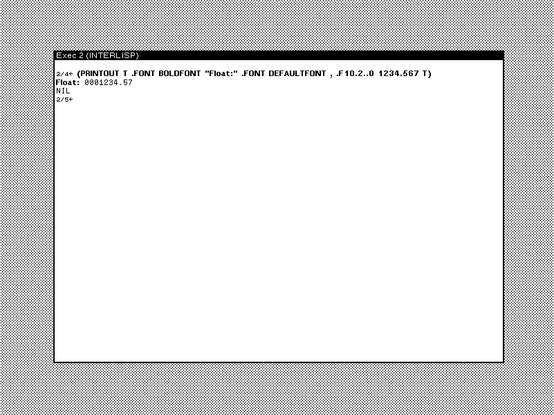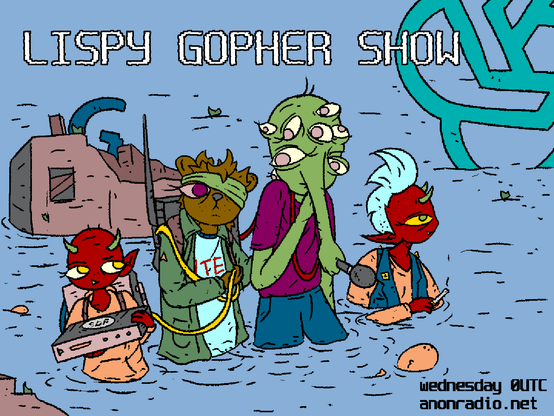The PRINTOUT output formatting function of Interlisp is similar to Common Lisp's FORMAT but also allows control over fonts and text attributes. In this example the first T is like the T stream of FORMAT, the second like ~%. The comma outputs a space.
Lisp Machines, Common Lisp, https://www.reddit.com/r/common_lisp
Every time I reread the classic Tutorial on Good Lisp Programming Style by Peter Norvig and Kent Pitman @kentpitman I discover and learn something new. It's dense with insight.
#lispyGopherClimate @kentpitman #live #interview #computerScience #programming #lisp #commonLisp #python with some special announcements and releases.
#teco #emacs #conditions
https://archives.anonradio.net/202502120000_screwtape.mp3
#archive Thanks for the incredible interview and livechat everyone!
Interview 1 / ?
Please drop questions here beforehand or join us live in #lambdaMOO as always !
telnet lambda.moo.mud.org 8888
co guest
@join screwtape
Joe Marshall started a blog post series about solving the 2024 Advent of Code problems in Common Lisp. Why now? Some of his motivations:
"I wanted to take my time and focus on code quality rather than on how fast I can write it."
[...]
"I want to show how to effectively use the rich set of Common Lisp library functions to write concise, readable, and efficient code."
@dougmerritt @northernlights @kentpitman @SDF @nosrednayduj @sacha @hairylarry @pkw @rat @pizzapal
Thanks for the incredible #interview and episode Kent Pitman and everyone ! Lots of #lisp #emacs #teco #programming #lore #unique #historicalNotes
https://archives.anonradio.net/202502120000_screwtape.mp3
(One hour)
Please do ping Kent (and me!) about topics you are particularly interested in Kent following up on in later interviews, or releasing from his personal software stockpiles.
Every week 0UTC Wednesadys on anonradio
@weekend_editor @kentpitman @runes Ah, I didn't know that it was original an IL program. I was also thinking of something like KEE (Knowledge Engineering Environment), from Intellicorp, which I would expect to be originally coming from Interlisp.
@weekend_editor @kentpitman @runes I read that TI converted their whole (?) Lispm OS to CL using a conversion tool. That's what the Symbolics docs have as chapters for the conversion tools...
How did the Interlisp tool work? Was it a compatibility layer or a translator?
@kentpitman @runes #lisp #interlisp #symbolics Some of the on Interlisp developed software was migrated to ZetaLisp and Common Lisp. Symbolics 36xx machines had a much larger memory space (real and virtual). That was useful for knowledge-based systems, which wanted to use a lot more memory, than the few megabytes, which Interlisp machines supported. If the software wasn't portable (costs, system dependency, ...) then later Medley could be used as an emulator, but I think that was rare.
@kentpitman @runes I've saw that advertised Interlisp support, too. In the early 80s there was a need to move away from Interlisp systems, because their supported real and virtual memory was very small. There was interesting software developed (not just GUI stuff) for Interlisp. At that time it was often the case to provide a migration way. Symbolics in some cases provided code migration in the editor. Maybe that was also here the case. #interlisp #lisp #symbolics
@mousebot names are internally uppercase. INTERN has two arguments: the name and the package. q:foo is symbol FOO in package Q. If the package exists but the symbol not: (intern "FOO" "Q") . If package and symbol exist: (find-symbol "FOO" "Q")
@johanmynhardt one can ask Lisp about it. DESCRIBE prints a short description of a data object.
CL-USER > (describe :|I woke up early this morning.|)
:|I woke up early this morning.| is a KEYWORD
NAME "I woke up early this morning."
VALUE :|I woke up early this morning.|
FUNCTION #<unbound function>
PLIST NIL
PACKAGE #<The KEYWORD package, 0/4 internal, 7626/8192 external>
Thus it is a symbol in the KEYWORD package.
@amoroso unfortunately the quote character is a backquote in the PDF, which makes it kind of unusable...
@amoroso see Symbolics Common Lisp programming concepts. Page 480ff Symbolics CLOS
@amoroso Symbolics Common Lisp is described in three manuals. CLOS is in one of them...
@amoroso #lisp core CLOS designers were 6 people, two from Symbolics (Keene + Moon). The Symbolics CLOS implementation was released with Genera 8 in 1990. It does not have the extensive MOP as the PCL implementation (PCL implementation also ran in Genera). Other than that it is a useful CLOS implementation. See for example: https://people.csail.mit.edu/cyphers/closimp.txt
@screwtape @ldbeth One thing that would be good to change: I see the quote character in the PDF as a backquote: (sample-function 1 2 2 ´bar). If I copy that from the PDF I get
(sample-function 1 2 2´bar)
instead of
(sample-function 1 2 2 'bar)
@mdhughes For me repeats are allowed. 🙂
practical languages and their implementations tend to be larger. Plus integrating more features sometimes has advantages over layering them, with less integration.
@mdhughes #lisp #documentation #scheme #commonlisp Which by the way includes Scheme (or related) implementations. Racket has very extensive (well designed and well written) documentation (far exceeding the size of CLtL2). The GUILE 3.0 PDF manual has almost 1000 pages.
On the PDF book side these I find useful (quickref, cookbook, ANSI CL, LispWorks)
https://github.com/LispCookbook/cl-cookbook/releases/tag/2025-01-09
https://franz.com/support/documentation/cl-ansi-standard-draft-w-sidebar.pdf


